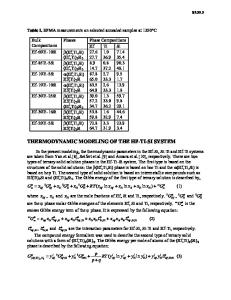Experimental Investigation and Thermodynamic Modeling of the Nd-Zr and the Mg-Nd-Zr Systems
- PDF / 3,216,537 Bytes
- 11 Pages / 593.972 x 792 pts Page_size
- 65 Downloads / 421 Views
CTION
RECENTLY, magnesium alloys have attracted many attentions because of their superior properties such as low density, good castability, etc.[1] However, the low melting point, limited creep resistance, and yield strength of magnesium alloys restrict their adoption in automotive applications.[2] Through alloying with rareearth (RE) element, the precipitation-strengthened magnesium–rare earth (Mg–RE) alloys have been developed to raise the operating temperature, as well as to improve the creep resistance and strength. WE54 (Mg-1.5 to 2.0 wt pct Nd-0.4 wt pct Zr-1.5 to 2.0 wt pct heavy RE-5.0 to 5.5 wt pct Y) and WE43 (Mg-2.25 wt pct Nd-0.6 wt pct Zr-4 wt pct Y) are typical examples, which have been successfully used in the practical application.[3–7] It is found that the selection and amount of RE elements as additions in Mg alloys strongly influence the final performance of the product. Therefore, it is important to consider the contributions of the individual RE content to optimize the property balance of a particular magnesium alloy.[8,9] The calculation of phase diagrams (CALPHAD) approach, which can provide accurate thermodynamic KAIMING CHENG and HUA ZHOU, Doctoral Students, YONG DU, LIJUN ZHANG, and HONGHUI XU, Professors, and SHUHONG LIU, Associate Professor, are with the State Key Laboratory of Powder Metallurgy, Central South University, Changsha, 410083 Hunan, P.R. China. Contact e-mail: [email protected] BIAO HU, Doctor, is with the School of Materials Science and Engineering, Anhui University of Science and Technology, Huainan, 232001 Anhui, P.R. China. LIBIN LIU, Professor, is with the School of Material Science and Engineering, Central South University, Changsha, 410083 Hunan, P.R. China. Manuscript submitted September 17, 2013. Article published online April 1, 2014 2708—VOLUME 45A, JUNE 2014
and phase transition information for intermetallic phases formed in the Mg–RE systems, can help one to save material and time to focus on optimal or even more promising systems.[1,8,10–12] Also, attempts are recently made to couple the thermodynamic database with the phase-field simulation approach to study the precipitation behavior and microstructure in Mg–RE alloys.[13] These studies are in the frame of computational material design and thus make the CALPHAD for the Mg alloy systems crucially necessary. So far, the Mg-Nd system with Zr as grain refiner is one of the bases for the development of creep-resistant magnesium alloys.[14–16] However, the knowledge of the phase equilibria and thermodynamic analysis in the MgNd-Zr system is rather limited. To the best of our knowledge, no phase diagram for the Nd-Zr system is available in the literature. The only information on the solubility of Nd in Zr at 1073 K (800 °C) is determined to be above 0.33 at. pct.[17] Consequently, the experimental investigation and thermodynamic optimization of the Nd-Zr system is first implemented in the current study. The experimental data for the Mg-Nd-Zr system are also quite limited. The available experimental data that can be
Data Loading...











